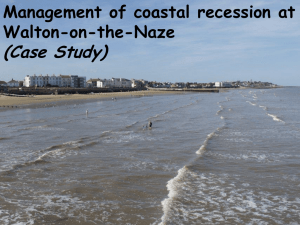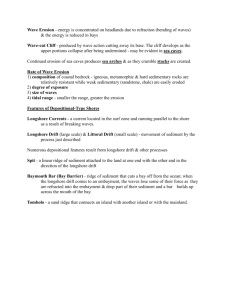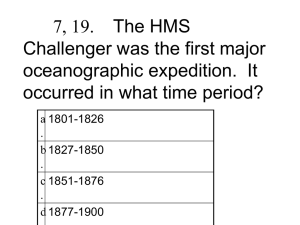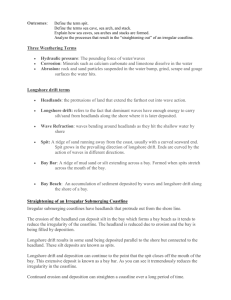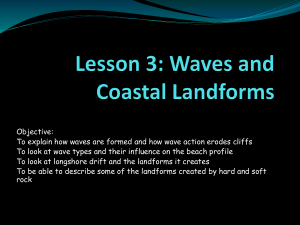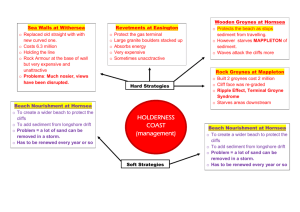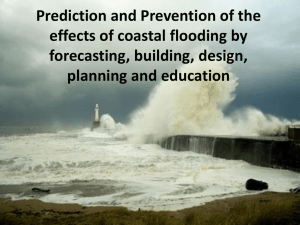TOPIC COASTLINES
advertisement
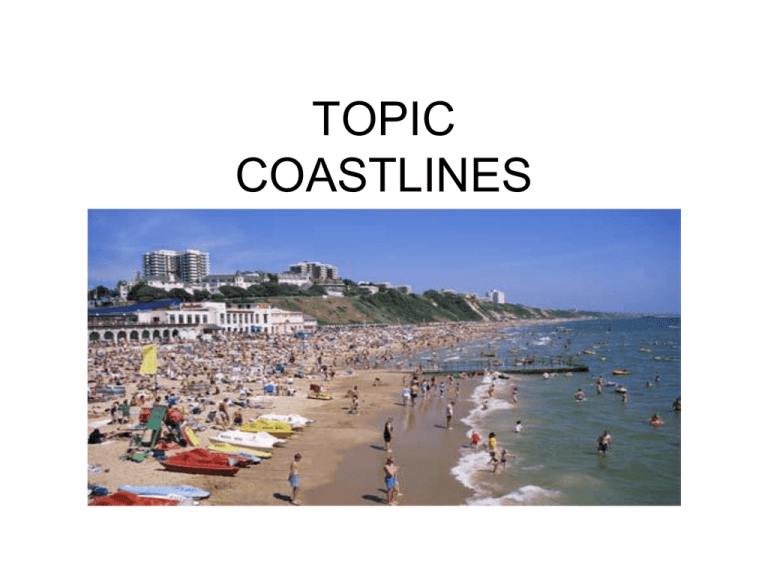
TOPIC COASTLINES Local Geology The coastline of the British Isles is not smooth. Why ? The nature of the rocks is important. Some are very hard but some are very soft and are eroded easily. Wave Action Destructive Waves Winds generate waves. Strong winds build powerful waves with lots of energy. Gentle winds produce gentle waves with low energy. Destructive waves have a very strong backwash and a weak swash. They remove beach material. Constructive Waves. These waves deposit material at the coast. They build up the coastline. The strong swash pushes sand / shingle up the beach. Features / Landforms produced by EROSION. • • • • • What are the processes of EROSION ? CORRASION ATTRITION SOLUTION HYDRAULIC ACTION. Jurassic Coast Dorset Bays and Headlands Cardigan Bay: Wales 1.Describe what has happened in these sketches. 2.Explain what has happened in these sketches. DURDLE DOOR in DORSET What will be formed when the arch collapses? Headland Erosion. OLD HARRY ROCKS The headland itself is eventually broken down by erosion. Remember the sequence of events : CAVES ARCHES STACKS + STUMPS Case study / Example OLD HARRY ROCKS in Dorset Cliffs and wave cut platforms These are the Severn Sisters On the south coast between Brighton / Eastbourne. Look for the point where the cliff line used to be. Notice the cliff line today. A great example of a wave cut platform! What is Longshore Drift ? Waves approach at an angle. Material is moved along the beach. Is longshore drift a good thing / bad thing ? Why ? Spit Formation Key Terms : EROSION-----------TRANSPORTATION ---------DEPOSITION Draw arrows to label the places on the sketch. Spit animation Watch how material is transported along the coastline by longshore drift. The coastline changes direction and the material is moved out to sea and deposited. Case study : Spurn Head Longshore Drift also creates…. SPITS This is Spurn Head the largest spit in the British Isles. What features are produced as a result of Longshore Drift ? The sand has moved along the coastline and formed a BAR. A bank of sand across the estuary. Why is Longshore Drift a problem? Longshore drift moves material along the coast. Places can be left with no sand / shingle to protect the coastline. The waves can easily attack / erode the cliffs. Case study of Holderness Where is the Holderness Coast? Holderness Coast In this photograph you can see that the beach is narrow and the cliff is open to attack from the waves. The house on the cliff top is under threat of collapse into the sea. Now watch some film clips of the Holderness Coast to see the effects of interfering with the natural process of Longshore Drift. Coastal Management What are Groynes ? • Longshore Drift moves material along the coastline leaving some parts unprotected. • How can we stop Longshore Drift ? Wooden Groynes trap beach material Examples of Groynes Look at how the waves approach at an angle to the shoreline. Note how material builds up on unevenly between the groynes. Are Groynes a good or bad thing? • Good Points : • Groynes Trap material and it builds ups protecting the coast. • Case study • Bournemouth Beach. • • • What has happened in this photograph ? Bad Points The natural movement of material is stopped and other places along the coast do not get the sand / shingle to protect the coastline. Case study Holdermess Coastal Protection • Some parts of our coastline are protected from erosion. Why? • To protect towns that have large populations and whose local economy depends on tourism or fishing or industry. Coastal Protection Coastal Protection Gabions are rocks held together with Wire netting. They stabilise cliffs. Rock Armour and curved sea wall. Coastal Protection Rip Rap wooden barriers hold rocks together Look at this sketch to see what defences have been built on Brighton Seafront. What is Managed Retreat? It can cost millions of pounds to build sea defences. Low value land is not worth protecting. Nature is allowed to take its natural course. Birling Gap near Eastbourne in Sussex Will not receive any money for coastal protection. This low value farmland will be allowed to flood. Case study of Bournemouth • Bournemouth Seafront is heavily defended. • Wide sand / shingle beach.Wide Promenade / Concrete sea wall. Gabions. Grass banks stabilise the soil. Bournemouth Facts. • • • • • Population 163.000 1.5 million visitors a year. Tourists spend over £130million a year. 7000 jobs in tourists sector. Bournemouth has: 7 miles of golden sands. • Bournemouth receives 7.7 hours of sunshine on average every day.
